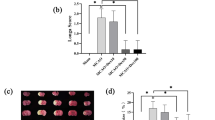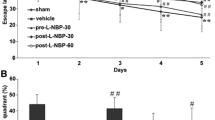Abstract
To investigate the effect of dexmedetomidine post-conditioning on the inflammatory response and autophagy effect of focal cerebral ischemia reperfusion injury in rats, and further to study its potential mechanisms. Water maze was conducted to evaluate spatial learning and memory ability of middle cerebral artery occlusion (MCAO) rats. TTC staining was used to observe the area of cerebral infarction. The expressions of inflammatory factors in serum were detected by ELISA. TUNEL assay, HE staining, and transmission electron microscopy were used to detect the apoptosis of neurons, neuro-cytopathic changes, and the formation of auto-phagosome in hippocampus CA1 region, respectively. The mRNA and protein expression of Beclin-1, Caspase-3, and light chain 3 (LC3) were detected by qRT-PCR and Western blot. Moreover, the activity of C-Jun N-terminal kinase (JNK) pathway was detected by Western blot. The escape latency (EL); cerebral infarction area ratio; positive apoptosis; neuron pathological changes; auto-phagosome numbers; inflammatory factor contents; mRNA and protein expressions of Beclin-1, Caspase-3 and LC3II/I; and the phosphorylation level of JNK were decreased, while the times across platform and the times stayed in the quadrant of the original platform were increased after dexmedetomidine treatment. However, the protective effect of dexmedetomidine on brain injury in MCAO rats was reversed by JNK pathway activator. Dexmedetomidine post-conditioning could improve learning and memory dysfunction caused by MCAO in rats and reduce the inflammatory response and autophagy effect. The mechanism may be related to inhibition of JNK pathway activation.






Similar content being viewed by others
References
Chen, F.Y., X.Y. Fang, and H. Zhang. 2018. Effect of polydatin on expression of p53 and Notch1 in brain tissue of ischemic cerebrovascular disease. Journal of Biological Regulators and Homeostatic Agents 32 (1): 133.
Hartley, A., D.C. Marshall, J.D. Salciccioli, M.B. Sikkel, M. Maruthappu, and J. Shalhoub. 2016. Trends in mortality from ischemic heart disease and cerebrovascular disease in EuropeClinical PERSPECTIVE: 1980 to 2009. Circulation 133 (20): 1916–1926.
Balestrino, M., M. Sarocchi, E. Adriano, and P. Spallarossa. 2016. Potential of creatine or phosphocreatine supplementation in cerebrovascular disease and in ischemic heart disease. Amino Acids 48 (8): 1955–1967.
Wang, M., J. Wang, Z. Liu, X. Guo, N. Wang, N. Jia, Y. Zhang, and J. Yuan. 2017. Effects of intermedin on autophagy in cerebral ischemia/reperfusion injury. Neuropeptides 68: 15-21.
Morselli, E., M.C. Maiuri, M. Markaki, E. Megalou, A. Pasparaki, K. Palikaras, A. Criollo, L. Galluzzi, S.A. Malik, and I. Vitale. 2010. The life span-prolonging effect of Sirtuin-1 is mediated by autophagy. Autophagy 6 (1): 186–188.
Bao, H., A. Benavides, Y. Shi, P. Frost, and A. Lichtenstein. 2009. Effect of autophagy on multiple myeloma cell viability. Molecular Cancer Therapeutics 8 (7): 1974.
Dosenko, V.E., V.S. Nagibin, L.V. Tumanovska, and A.A. Moibenko. 2006. Protective effect of autophagy in anoxia-reoxygenation of isolated cardiomyocyte? Autophagy 2 (4): 305–306.
Gu, Y., C. Wang, and A. Cohen. 2004. Effect of IGF-1 on the balance between autophagy of dysfunctional mitochondria and apoptosis. FEBS Letters 577 (3): 357–360.
Zhang, X., Y. Dong, X. Zeng, X. Liang, X. Li, W. Tao, H. Chen, Y. Jiang, L. Mei, and S.S. Feng. 2014. The effect of autophagy inhibitors on drug delivery using biodegradable polymer nanoparticles in cancer treatment. Biomaterials 35 (6): 1932–1943.
Lu, N., B. Wang, X. Deng, H. Zhao, Y. Wang, and D. Li. 2014. Autophagy occurs within an hour of adenosine triphosphate treatment after nerve cell damage:the neuroprotective effects of adenosine triphosphate against apoptosis. Neural Regeneration Research 9 (17): 1599–1605.
Wang, L., P. Wang, H. Dong, S. Wang, H. Chu, W. Yan, and X. Zhang. 2018. Ulk1/FUNDC1 prevents nerve cells from hypoxia-induced apoptosis by promoting cell autophagy. Neurochemical Research 43 (8): 1539–1548.
Cherra, S.J., S.M. Kulich, G. Uechi, M. Balasubramani, J. Mountzouris, B.W. Day, and C.T. Chu. 2010. Regulation of the autophagy protein LC3 by phosphorylation. The Journal of Cell Biology 190 (4): 533–539.
Tanida, I., N. Minematsu-Ikeguchi, T. Ueno, and E. Kominami. 2005. Lysosomal turnover, but not a cellular level, of endogenous LC3 is a marker for autophagy. Autophagy 1 (2): 84–91.
Ashkenazi, A., C.F. Bento, T. Ricketts, M. Vicinanza, F. Siddiqi, M. Pavel, F. Squitieri, M.C. Hardenberg, S. Imarisio, and F.M. Menzies. 2017. Polyglutamine tracts regulate beclin 1-dependent autophagy. Nature 545 (7652): 108–111.
Kawamura, N., A.M. Schmeichel, Y. Wang, J. Schmelzer, and P. Low. 2006. Multiple effects of hypothermia on inflammatory response following ischemia-reperfusion injury in experimental ischemic neuropathy. Experimental Neurology 202 (2): 487–496.
Shin, I.W., I.S. Jang, S.M. Lee, K.E. Park, S.H. Ok, J.T. Sohn, H.K. Lee, and Y.K. Chung. 2011. Myocardial protective effect by ulinastatin via an anti-inflammatory response after regional ischemia/reperfusion injury in an in vivo rat heart model. Korean Journal of Anesthesiology 61 (6): 499–505.
Prieto-Moure, B., J.M. Lloris-Carsí, M. Belda-Antolí, L.H. Toledo-Pereyra, and D. Cejalvo-Lapeña. 2016. Allopurinol protective effect of renal ischemia by downregulating TNF-α, IL-1β, and IL-6 response. Journal of Investigative Surgery 30 (3): 143–151.
Xiang, Y., W. Ye, C. Huang, B. Lou, J. Zhang, D. Yu, X. Huang, B. Chen, and M. Zhou. 2017. Brusatol inhibits growth and induces apoptosis in pancreatic cancer cells via JNK/p38 MAPK/NF-κb/Stat3/Bcl-2 signaling pathway. Biochemical and Biophysical Research Communications 487 (4): 820–826.
Zhong, L., Z.L. Zhang, X. Li, C. Liao, P. Mou, T. Wang, Z. Wang, Z. Wang, M. Wei, and H. Xu. 2017. TREM2/DAP12 complex regulates inflammatory responses in microglia via the JNK signaling pathway. Frontiers in Aging Neuroscience 9: 204.
Ge, X.H., G.J. Zhu, D.Q. Geng, H.Z. Zhang, J.M. He, A.Z. Guo, L.L. Ma, and D.H. Yu. 2017. Metformin protects the brain against ischemia/reperfusion injury through PI3K/Akt1/JNK3 signaling pathways in rats. Physiology & Behavior 170: 115–123.
Hoy, S.M., and G.M. Keating. 2011. Dexmedetomidine: a review of its use for sedation in mechanically ventilated patients in an intensive care setting and for procedural sedation. Drugs 71 (11): 1481–1501.
Gu, J., P. Sun, H. Zhao, H.R. Watts, R.D. Sanders, N. Terrando, P. Xia, M. Maze, and D. Ma. 2011. Dexmedetomidine provides renoprotection against ischemia-reperfusion injury in mice. Critical Care 15 (3): R153.
Ibacache, M., G. Sanchez, Z. Pedrozo, F. Galvez, C. Humeres, G. Echevarria, J. Duaso, M. Hassi, L. Garcia, and G. Díazaraya. 2012. Dexmedetomidine preconditioning activates pro-survival kinases and attenuates regional ischemia/reperfusion injury in rat heart. Biochimica et Biophysica Acta 1822 (4): 537–545.
Si, Y., H. Bao, L. Han, H. Shi, Y. Zhang, L. Xu, C. Liu, J. Wang, X. Yang, and A. Vohra. 2013. Dexmedetomidine protects against renal ischemia and reperfusion injury by inhibiting the JAK/STAT signaling activation. Journal of Translational Medicine 11: 141.
Yeda, X., L. Shaoqing, H. Yayi, Z. Bo, W. Huaxin, C. Hong, X. Zhongyuan, X. Yeda, L. Shaoqing, and H. Yayi. 2017. Dexmedetomidine protects against renal ischemia and reperfusion injury by inhibiting the P38-MAPK/TXNIP signaling activation in streptozotocin induced diabetic rats. Acta Cirúrgica Brasileira 32 (6): 429–439.
Huang, J., X. Ye, Y. You, W. Liu, Y. Gao, S. Yang, J. Peng, Z. Hong, J. Tao, and L. Chen. 2014. Electroacupuncture promotes neural cell proliferation in vivo through activation of the ERK1/2 signaling pathway. International Journal of Molecular Medicine 33 (6): 1547–1553.
Xie, G., S. Yang, A. Chen, L. Lan, Z. Lin, Y. Gao, J. Huang, J. Lin, J. Peng, and J. Tao. 2013. Electroacupuncture at Quchi and Zusanli treats cerebral ischemia-reperfusion injury through activation of ERK signaling. Experimental and Therapeutic Medicine 5 (6): 1593–1597.
Cheng, J., P. Zhu, H. Qin, X. Li, H. Yu, H. Yu, and X. Peng. 2018. Dexmedetomidine attenuates cerebral ischemia/reperfusion injury in neonatal rats by inhibiting TLR4 signaling. The Journal of International Medical Research 46 (7): 2925–2932.
Dong, J., X. Guo, S. Yang, and L. Li. 2017. The effects of dexmedetomidine preconditioning on aged rat heart of ischaemia reperfusion injury. Research in Veterinary Science 114: 489–492.
Riquelme, J.A., F. Westermeier, A.R. Hall, J.M. Vicencio, Z. Pedrozo, M. Ibacache, B. Fuenzalida, L. Sobrevia, S.M. Davidson, and D.M. Yellon. 2016. Dexmedetomidine protects the heart against ischemia-reperfusion injury by an endothelial eNOS/NO dependent mechanism. Pharmacological Research 103: 318–327.
Li, W.L., S.P. Yu, D. Chen, S.S. Yu, Y.J. Jiang, T. Genetta, and L. Wei. 2013. The regulatory role of NF-κB in autophagy-like cell death after focal cerebral ischemia in mice. Neuroscience 244: 16–30.
Zheng, Y., J. Hou, J. Liu, M. Yao, L. Li, B. Zhang, H. Zhu, and Z. Wang. 2014. Inhibition of autophagy contributes to melatonin-mediated neuroprotection against transient focal cerebral ischemia in rats. Journal of Pharmacological Sciences 124 (3): 354–364.
Eskelinen, E.L., F. Reggiori, M. Baba, A.L. Kovács, and P.O. Seglen. 2011. Seeing is beieving: the impact of electron microscopy on autophagy research. Autophagy 7 (9): 935–956.
Kang, R., H.J. Zeh, M.T. Lotze, and D. Tang. 2011. The Beclin 1 network regulates autophagy and apoptosis. Cell Death and Differentiation 18 (4): 571–580.
Wang, C.P., Y.W. Shi, M. Tang, X.C. Zhang, Y. Gu, X.M. Liang, Z.W. Wang, and F. Ding. 2017. Isoquercetin ameliorates cerebral impairment in focal ischemia through anti-oxidative, anti-inflammatory, and anti-apoptotic effects in primary culture of rat hippocampal neurons and hippocampal CA1 region of rats. Molecular Neurobiology 54 (3): 2126–2142.
Haberzettl, P., and B.G. Hill. 2013. Oxidized lipids activate autophagy in a JNK-dependent manner by stimulating the endoplasmic reticulum stress response. Redox Biology 1: 56–64.
Zhou, Y.Y., Y. Li, W.Q. Jiang, and L.F. Zhou. 2015. MAPK/JNK signalling: a potential autophagy regulation pathway. Bioscience Reports 35: 3.
Gomez-Sanchez, J.A., L. Carty, M. Iruarrizaga-Lejarreta, M. Palomo-Irigoyen, M. Varela-Rey, M. Griffith, J. Hantke, N. Macias-Camara, M. Azkargorta, and I. Aurrekoetxea. 2015. Schwann cell autophagy, myelinophagy, initiates myelin clearance from injured nerves. The Journal of Cell Biology 210 (1): 153–168.
Author information
Authors and Affiliations
Corresponding author
Ethics declarations
Conflict of Interest
The authors declare that they have no conflict of interest.
Additional information
Publisher’s Note
Springer Nature remains neutral with regard to jurisdictional claims in published maps and institutional affiliations.
Rights and permissions
About this article
Cite this article
Zhu, Y., Li, S., Liu, J. et al. Role of JNK Signaling Pathway in Dexmedetomidine Post-Conditioning-Induced Reduction of the Inflammatory Response and Autophagy Effect of Focal Cerebral Ischemia Reperfusion Injury in Rats. Inflammation 42, 2181–2191 (2019). https://doi.org/10.1007/s10753-019-01082-2
Published:
Issue Date:
DOI: https://doi.org/10.1007/s10753-019-01082-2




